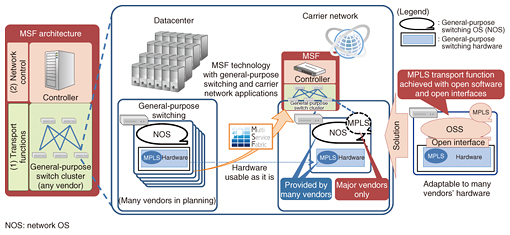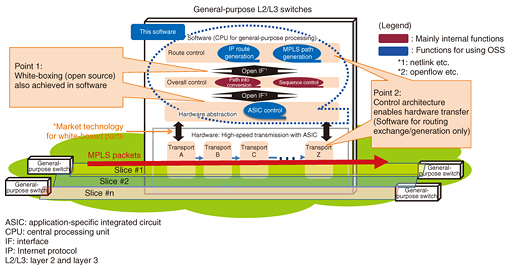 |
|||||||||||
|
|
|||||||||||
|
Short Reports Vol. 15, No. 1, pp. 37–39, Jan. 2017. https://doi.org/10.53829/ntr201701sr1 Achieving Tbit/s-level Transport Functions with
|
|||||||||||
| *1 | White-box switch: General-purpose communications equipment that runs on equipment vendor hardware, for which software can be freely selected and developed. |
| *2 | Network OS: Control software that runs internally in network equipment such as routers and switches. |
2. Background
Server performance and software technologies have improved in recent years, and with this, more and more virtual technologies have been adopted to economically achieve higher scalability and reliability, mainly in datacenters. The adaptation of these technologies for carrier networks by virtualizing computer and hardware resources has been gaining attention.
In line with the NetroSphere concept, NTT aims to provide both virtualization and fast, highly reliable, and even more diverse services to customers and service providers by driving commonization and modularization of network equipment. As part of these efforts, NTT is promoting its MSF initiatives to build networks using general-purpose equipment by using general-purpose products with simple functionality instead of specialized equipment with high functionality. Because network functions can be developed independently, MSF provides network architecture in which simplified hardware for transport functions and software for network control can be separated and redefined. This architecture is aimed at achieving transport functions that make maximum use of generic network switches (general-purpose switches) as well as flexible software functionality for network control.
3. Software that maximizes the use of white-box switching
MSF uses generic switches mainly used in datacenters and is aimed at achieving carrier network virtualization (to configure network slices), although this requires transport functions that use MPLS technologies. To date, however, MPLS transport functions have only been provided with software (network OS) by some router vendors, even though hardware is equipped with many general-purpose switches.
Hence, NTT has created a software product that is equivalent to a network OS. The product can be mounted on white-box switches to achieve MPLS transport functionality by making full use of hardware performance (Fig. 1).

Fig. 1. MSF transfer function problems and solutions.
4. Software overview and effects
The software uses two techniques to achieve MPLS transport. It generates optimal pathways by exchanging network path data with other MPLS routers, and it writes the generated paths to hardware through an interface that supports MPLS transport (Fig. 2). The software functions are configured using only commercially available open source technologies such as open source software (OSS), so white-boxing is possible even in internal software configurations. At the same time, using architecture that maximizes hardware performance enables high-capacity, carrier-grade transport with white-box switching (1 Tbit/s/tens of thousands of paths).

Fig. 2. Technical overview (software for white-box switches).
These achievements mean that it is possible to apply general-purpose switches to carrier networks, and consequently, equipment vendors will be able to pioneer new markets (for general-purpose switches for carrier networks), which should bring down prices for general-purpose switches as well as lead to additional functionality through competition among vendors. Moreover, carriers will have a greater selection of equipment with which to build networks, and they will be able to modify network OS software by themselves.
These developments are driving the NetroSphere concept and MSF objectives of network commonization and modularization and will make it easier to meet customer requirements with even faster communication speeds.
5. Future outlook
Beginning with NetroSpherePIT, NTT plans to carry out studies on experimental operations and further expansion of functionality in order to establish this technology, and to engage in even greater levels of openness by forming wide-ranging partnerships with various organizations.
References
| [1] | Press release issued by NTT on February 19, 2015.
http://www.ntt.co.jp/news2015/1502e/150219a.html |
|---|---|
| [2] | K. Takahashi, H. Yoshioka, K. Ono, and T. Iwai, “Promoting the MSF Architecture for Flexible Networks,” NTT Technical Review, Vol. 14, No. 10, 2016.
https://www.ntt-review.jp/archive/ntttechnical.php?contents=ntr201610fa6.html |
| [3] | T. Okutani, A. Kawabata, T. Kotani, T. Yamada, and M. Maruyama, “NetroSpherePIT: Demonstrations to Accelerate the Adoption of NetroSphere,” NTT Technical Review, Vol. 14, No. 10, 2016.
https://www.ntt-review.jp/archive/ntttechnical.php?contents=ntr201610fa2.html |
For Inquiries
Planning Department, Public Relations Section
NTT Information Network Laboratory Group
Email: inlg-pr@lab.ntt.co.jp








